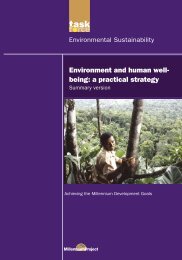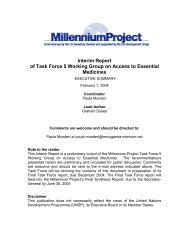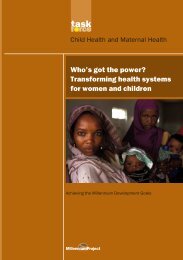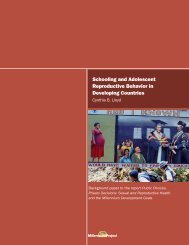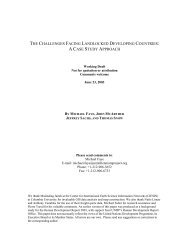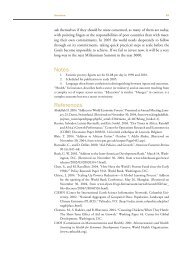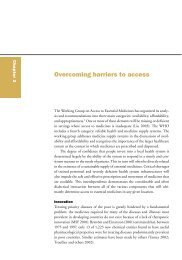Public Choices, Private Decisions: Sexual and Reproductive Health ...
Public Choices, Private Decisions: Sexual and Reproductive Health ...
Public Choices, Private Decisions: Sexual and Reproductive Health ...
Create successful ePaper yourself
Turn your PDF publications into a flip-book with our unique Google optimized e-Paper software.
2<br />
Executive summary<br />
Up to 50<br />
percent<br />
of women<br />
in some<br />
countries<br />
still marry or<br />
enter a union<br />
by age 18<br />
regional variation. Due in large part to the HIV/AIDS crisis, the reproductive<br />
health disease burden accounts for about one third of Africa’s total disease burden,<br />
which is almost double that of most other regions. And death <strong>and</strong> disability<br />
is only a portion of the impact of SRH on the quality of life <strong>and</strong> the prospects for<br />
development. The record of progress in SRH in recent decades is mixed.<br />
Fertility<br />
Although significant declines in fertility have occurred in most regions of the<br />
world, these have recently slowed in several countries. In many sub-Saharan<br />
African countries the fertility transition remains in its early stages. National<br />
level fertility declines also disguise significant variations within countries. Poor<br />
<strong>and</strong> rural populations often have the least access to family planning information<br />
<strong>and</strong> services, <strong>and</strong> thus the highest fertility rates.<br />
Adolescent reproductive health<br />
Adolescents, currently about 20 percent of the world’s population, have special<br />
reproductive health concerns <strong>and</strong> face risks related to early sexual experience,<br />
marriage <strong>and</strong> fertility. A rise in the age of marriage globally has contributed to<br />
declines in adolescent fertility. However, up to 50 percent of women in some<br />
countries still marry or enter a union by age 18, with this figure rising to 70 percent<br />
by age 20. The proportion of young women married or in union by age 20 is<br />
closely linked to adolescent fertility <strong>and</strong> exposure to reproductive health risks.<br />
Family planning<br />
Contraceptive use accounts for a substantial portion of the variation in<br />
observed fertility rates (others include age of marriage, abortion rates, postpartum<br />
amenorrhea <strong>and</strong> abstinence, <strong>and</strong> occurrence of marital separations).<br />
Although there have been dramatic increases in the use of family planning<br />
services, unmet need for family planning remains very high in low-prevalence<br />
regions. While contraceptive use among adolescents has been on the rise, data<br />
from 94 national surveys taken over the past decade demonstrate that the<br />
unmet need of adolescents is over two times higher than that of the general<br />
population in these countries. In this age group, unmet need for family planning<br />
is predominantly a desire to delay pregnancy. Addressing these preferences<br />
could reduce exposure to reproductive risks <strong>and</strong> empower young women<br />
in education, employment <strong>and</strong> social participation.<br />
Men are involved in reproductive health efforts as advocates for needed<br />
services, as supporters of their partner’s needs <strong>and</strong> as recipients of services for<br />
their health <strong>and</strong> well-being. The majority of men aged 20–24 report having<br />
had sexual intercourse before their 20th birthday, with a substantial proportion<br />
having had sex before their 15th birthday. A large proportion of married men<br />
aged 25–39, particularly in sub-Saharan Africa, say that they have not discussed<br />
family planning with their partners. Yet, men in many settings are more likely





